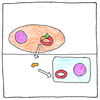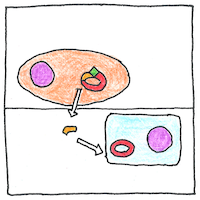Frederick Griffith
genetics

|
Transformation
Frederick Griffith showed, before we knew about DNA, that live bacteria could incorporate genes from dead bacteria, transforming themselves from a nonvirulent form into a form that could kill mice.
Horizontal gene transfers
Mitochondria, organelles that provide energy for all our cells, could originally have been bacteria incorporated by early eukaryotes. Plastids in plants and algae that perform photosynthesis or other chemical synthesis for energy could originally have been cyanobacteria. The genomes of mitochondria and plastids are circular, as are the chromosome of prokaryotes.
Competence
Griffith called it “competence,” but it’s more like susceptibility. Challenge a creature by starving it or cramming it together with others and in its weakened state it more readily admits a foreign genome. This discovery is significant for genetics and evolutionary theory.
One on one
One on one who’s to say promiscuity doesn’t pay.



The world of small creatures, where natural selection is aided by at least four mechanisms for horizontal gene tranfers, is more promiscuous than you might think.
See also in The book of science:
Readings in wikipedia: